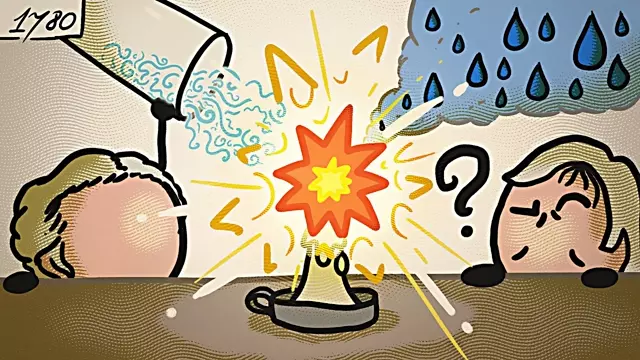2022-11-14
[public] 54.1K views, 37.1K likes, dislikes audio only
Keep exploring at https://brilliant.org/MinuteEarth. Get started for free, and hurry – the first 200 people get 20% off an annual premium subscription.
For thousands of years, water was thought to be an element. That is, until some of the greatest chemists in the world managed to crack it open.
LEARN MORE
**************
To learn more about this topic, start your googling with these keywords:
- Chemical element: is a species of atoms that have a given number of protons in their nuclei. Chemical elements cannot be broken down into simpler substances by any chemical reaction.
- Atom: is the smallest unit of ordinary matter that forms a chemical element.
- Molecule: is a group of two or more atoms held together by attractive forces known as chemical bonds.
- Inflammable air: an old name for hydrogen.
- Hydrogen: is the most abundant chemical substance in the universe. Early chemists identified hydrogen gas because it was colorless, odorless and highly combustible. Hydrogen means "maker of water" in Greek.
- Dephlogisticated air: an old name for oxygen.
- Oxygen: is Earth's most abundant element. Early chemists identified oxygen gas because it was colorless, odorless and was essential for respiration and combustion.
- Diatomic molecules: are molecules composed of only two atoms, of the same or different chemical elements. At standard conditions, both hydrogen and oxygen are gasses of diatomic molecules (H2 and O2, respectively).
- Water: is an inorganic, transparent, odorless, and nearly colorless chemical substance, which is the main constituent of Earth's hydrosphere and the fluids of all known living organisms. It is vital for all known forms of life. Its chemical formula, H2O, indicates that each of its molecules contains one oxygen and two hydrogen atoms.
- Combustion (or burning): is a chemical reaction between a fuel and an oxidizing agent (like oxygen gas), that produces oxidized, often gaseous products, in a mixture termed as smoke.
- Electrolysis: is a technique that uses direct electric current to drive an otherwise non-spontaneous chemical reaction.
- Avogadro's Law (sometimes referred to as Avogadro's hypothesis): is an experimental gas law that states that equal volumes of all gases, at the same temperature and pressure, have the same number of molecules.
SUPPORT MINUTEEARTH
**************************
If you like what we do, you can help us!:
- Become our patron: https://patreon.com/MinuteEarth
- Share this video with your friends and family
- Leave us a comment (we read them!)
CREDITS
*********
Ever Salazar | Co-writer, Narrator and Co-director
Cameron Duke | Co-writer and Co-director
Arcadi Garcia Rius | Illustration, Video Editing and Animation
Nathaniel Schroeder | Music
MinuteEarth is produced by Neptune Studios LLC
OUR STAFF
************
Lizah van der Aart • Sarah Berman • Cameron Duke
Arcadi Garcia i Rius • David Goldenberg • Melissa Hayes
Alex Reich • Henry Reich • Peter Reich
Ever Salazar • Leonardo Souza • Kate Yoshida
OUR LINKS
************
Merch | http://dftba.com/minuteearth
MinuteEarth Explains Book | https://minuteearth.com/books
Youtube | https://youtube.com/MinuteEarth
TikTok | https://tiktok.com/@minuteearth
Twitter | https://twitter.com/MinuteEarth
Instagram | https://instagram.com/minute_earth
Facebook | https://facebook.com/Minuteearth
Website | https://minuteearth.com
Apple Podcasts| https://podcasts.apple.com/us/podcast/minuteearth/id649211176
REFERENCES
**************
Cavendish, H. (1784), XIII. Experiments on air. Phil. Trans. R. Soc. 74:119–153. https://doi.org/10.1098/rstl.1784.0014
Watt, J. (1784), XXV. Thoughts on the constituent parts of water and of dephlogisticated air. Phil. Trans. R. Soc.74. 329–353. https://doi.org/10.1098/rstl.1784.0026
Lavoisier, A. (1789). Elements of Chemistry. Chapter VIII, p.87-102. https://www.gutenberg.org/ebooks/30775
(Original: https://gallica.bnf.fr/ark:/12148/btv1b8615746s)
Dalton, J. (1808). A New System of Chemical Philosophy. Part II, Chapter V, Section 1, p.272-276 and p.561 (Plate 5). https://doi.org/10.5479/sil.324338.39088000885681
Cannizzaro, S. (1858). Sketch of a Course of Chemical Philosophy. p.321. https://archive.org/details/sketchofcourseof00cannrich/
James Watt, and the Discovery of the Composition of Water. Nature 57:546–551 (1898). https://doi.org/10.1038/057546b0
West, J. B. (2014), Henry Cavendish (1731–1810): hydrogen, carbon dioxide, water, and weighing the world. Am J Physiol Lung Cell Mol Physiol 307: L1–L6. https://doi.org/10.1152/ajplung.00067.2014
Held, L. (2017). Avogadro's Hypothesis after 200 Years. Universal Journal of Educational Research, 5(10), 1718 - 1722. https://doi.org/10.13189/ujer.2017.051007
Katz, E. (2021), Electrochemical contributions: William Nicholson (1753–1815). Electrochem. Sci. Adv., 1: e2160003. https://doi.org/10.1002/elsa.202160003
https://patreon.com/minuteearth
/youtube/video/4DF94Wvtekk

